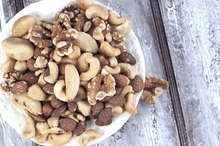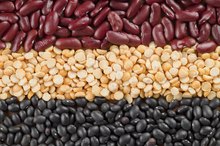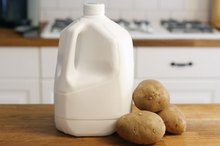What does fact checked mean?
At Healthfully, we strive to deliver objective content that is accurate and up-to-date. Our team periodically reviews articles in order to ensure content quality. The sources cited below consist of evidence from peer-reviewed journals, prominent medical organizations, academic associations, and government data.
- MedlinePlus: Amino Acids
- European Journal of Clinical Nutrition: Evaluation of a Novel Food Composition Database that Includes Glutamine and Other Amino Acids Derived from Gene Sequencing Data, Table 2
- European Journal of Clinical Nutrition: Evaluation of a Novel Food Composition Database that Includes Glutamine and Other Amino Acids Derived from Gene Sequencing Data, Table 2
The information contained on this site is for informational purposes only, and should not be used as a substitute for the advice of a professional health care provider. Please check with the appropriate physician regarding health questions and concerns. Although we strive to deliver accurate and up-to-date information, no guarantee to that effect is made.
What Is the Difference Between L-Lysine & L-Glutamine?
Lysine and glutamine are two of the 20 amino acids your body needs in order to make the proteins it uses to build and repair cellular tissue, support normal growth and development and break down food 1. Without enough of either amino acid, you may develop anemia, have trouble recovering from illnesses or experience reproductive and digestive problems, nausea, delayed growth, dizziness and fatigue. L-lysine and L-glutamine are the naturally occurring forms of each amino acid.
Type of Amino Acid
Lysine is one of the nine essential amino acids 1. Essential amino acids are those your body cannot make and that you must obtain either from food or dietary supplements 1. By contrast, glutamine is considered a conditional amino acid. These are amino acids that may become essential if you are sick or injured, undergo surgery or exercise heavily 1. In these instances, you'll need to consume glutamine to get enough.
Function in the Body
Lysine & Iron
Learn More
Your body needs adequate lysine to help synthesize the collagen that produces and maintains bones and connective tissue. Lysine is also required for the production of carnitine, a compound that takes part in the breakdown of dietary fats and the regulation of blood cholesterol levels. Glutamine supports the health and function of the nervous, digestive and immune systems and helps you eliminate excess ammonia. Your body can convert glutamine to glucose if your cells need energy.
- Your body needs adequate lysine to help synthesize the collagen that produces and maintains bones and connective tissue.
- Glutamine supports the health and function of the nervous, digestive and immune systems and helps you eliminate excess ammonia.
Possible Health Benefits
Supplemental glutamine may help athletes recover after exercise, though more research is needed. As part of a high-protein diet, glutamine and lysine support new protein synthesis, which is essential for repairing microscopic muscle tears that occur during exercise. Lysine also helps your body process calcium properly, improving calcium absorption from your diet, notes the University of Maryland Medical Center 346. Because calcium is essential to bone health, lysine might help keep your skeleton strong, but more research is needed to know for sure.
- Supplemental glutamine may help athletes recover after exercise, though more research is needed.
- As part of a high-protein diet, glutamine and lysine support new protein synthesis, which is essential for repairing microscopic muscle tears that occur during exercise.
Best Food Sources
Glutamine Powder or Capsules
Learn More
Red meat, fish, poultry, soy, eggs, nuts and dairy products are good sources of lysine. Raw soybeans contain 5 grams of lysine per cup, while a fillet of beef rib-eye steak supplies 4.1 grams, and a 3-ounce serving of roasted turkey breast meat has about 2.6 grams. Like lysine, glutamine is found in high concentrations in most protein-rich foods. A study published in the "European Journal of Clinical Nutrition" in 2009 reported that beef contains 1.2 grams of glutamine in every 3.5-ounce serving and that an equivalent serving of tofu has 0.6 gram 9.
- Red meat, fish, poultry, soy, eggs, nuts and dairy products are good sources of lysine.
- A study published in the "European Journal of Clinical Nutrition" in 2009 reported that beef contains 1.2 grams of glutamine in every 3.5-ounce serving and that an equivalent serving of tofu has 0.6 gram 9.
Related Articles
References
- MedlinePlus: Amino Acids
- ASU School of Life Sciences: Protein Parts
- University of Maryland Medical Center: Lysine
- University of Maryland Medical Center: Glutamine
- University of Michigan Health System: Glutamine
- University of Michigan Health System: Lysine
- USDA National Nutrient Database: Nutrients - Lysine (g)
- USDA National Nutrient Database: Full Report (All Nutrients) - 05711, Turkey, Retail Parts, Breast, Meat Only, Cooked, Roasted
- European Journal of Clinical Nutrition: Evaluation of a Novel Food Composition Database that Includes Glutamine and Other Amino Acids Derived from Gene Sequencing Data, Table 2
- Jayce_ View Profile (PjSanford)
- thunder_thighs View Profile
- KarlDevicky View Profile
Writer Bio
Michelle Kerns writes for a variety of print and online publications and specializes in literature and science topics. She has served as a book columnist since 2008 and is a member of the National Book Critics Circle. Kerns studied English literature and neurology at UC Davis.









